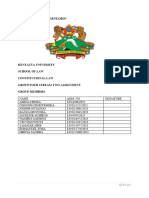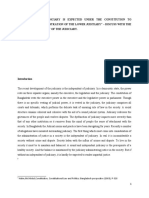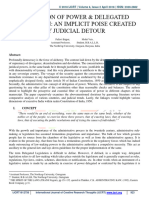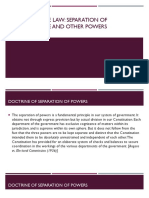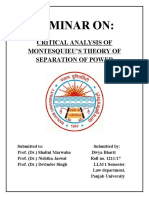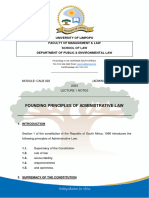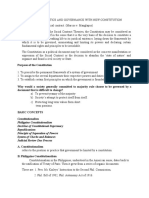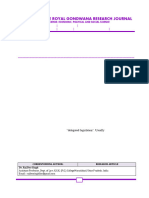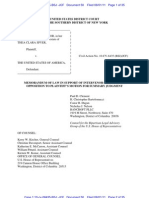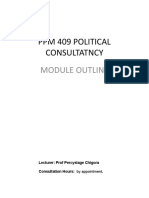CSL 2601 Discussiondocument
CSL 2601 Discussiondocument
Uploaded by
DAWA JAMES GASSIMCopyright:
Available Formats
CSL 2601 Discussiondocument
CSL 2601 Discussiondocument
Uploaded by
DAWA JAMES GASSIMOriginal Title
Copyright
Available Formats
Share this document
Did you find this document useful?
Is this content inappropriate?
Copyright:
Available Formats
CSL 2601 Discussiondocument
CSL 2601 Discussiondocument
Uploaded by
DAWA JAMES GASSIMCopyright:
Available Formats
lOMoARcPSD|6171195
CSL2601++Discussion+document
Constitutional Law (University of South Africa)
StuDocu is not sponsored or endorsed by any college or university
Downloaded by DAWA JAMES GASSIM (dawajamesgassim20@gmail.com)
lOMoARcPSD|6171195
2019 \02\ CSL2601 DISCUSSION DOCUMENT
STUDY UNIT 2: BASIC CONCEPTS
1 Separation of powers
Briefly on the history of the doctrine of separation of powers
John Locke was concerned that absolute monarchic power should not be
replaced by absolute parliamentary power.
Locke warned against the dangers of any one institution, even parliament
having too much power
French theorist Montesquieu devised the modern concept of separation of
powers that envisaged division of government power into three branches
It was against the danger of an overconcentration of power in the hands of the
monarch that the need to distribute power became evident
The principle seeks to limit the power of each individual branch of
government
The purpose of the doctrine of separation of power is to ensure that power is
not concentrated into one institution
-this is to prevent abuse of power
its premised on the understanding that the more transparent way to prevent
tyranny is by distributing power between different branches of government
The 4 principles that are generally accepted as the pillars on which the doctrine of
separation of powers is based are:
The division of government power across the three branches ( Trias politica)
Conferring distinct areas of responsibility and authority (functions) on each of
the 3 branches
Assignment of specific persons who are responsible for the performance of
that branch’s function
The provision of checks and balances entails that one branch can be held
accountable by the other branches to check the exercise of power by that
branch
The South African experience on the separation of powers
Constitutional principle V1 in the interim constitution required that the final
constitution incorporates a system of separation of powers
There is no universal model of separation of powers (De Lange v Smuts 1998
(3) SA 785 (CC) para 60)
There is no separation that is absolute in a democratic system of government
Although there is no explicit reference or mention to separation of powers in
the constitution it is implicit in the constitution (South African Association of
Personal Injury Lawyers v Heath (2001 (1) BCLR) 77)
Downloaded by DAWA JAMES GASSIM (dawajamesgassim20@gmail.com)
lOMoARcPSD|6171195
The structure of the constitution clearly makes provision for separation of
powers in terms of its institutional and substantive arrangements (First
Certification of the constitution of Sa judgment para 106-1130
Can infer the implicitness of the doctrine in the constitution from the way
government power is actual distributed between the legislature, the executive
and he judiciary
Section 43 vests the legislative authority of the Republic in Parliament,
provincial legislatures and municipal councils
Section 85 vests the executive authority to the President- President
exercise the authority together with the Cabinet
Section 165 (1) vests the judicial authority in the courts
The counter-majoritarian dilemma
Considering the separation of powers, the Judiciary is empowered to review and set
aside the actions of the other branches of government
Thus, the judiciary wields enormous power even though its members are not
democratically elected
The system of judicial review permits an unelected judiciary to declare
unconstitutional and invalid laws made and actions taken by democratically
elected and accountable members of the legislature and executive
How do we account for the fact that judicial review allows for the invalidation
of laws supported by a majority in a constitutional democracy?
What makes the decision of a few unelected judges carry more weight than
the choices of the majority
These questions are commonly referred to as the counter-majoritarian dilemma or
difficult
The essence of the dilemma is that judicial review, while recognised as having a
legitimate purpose in the main, involves the courts taking undemocratic decisions
that often go against the popular will
In US the system of judicial review has been subject of much controversy among US
scholars
The main attempts to account suitable for counter majoritarianism have elicited three
main types of responses
Some view judicial review as being severe constraint on the participation of
citizens in political decisions affecting them-irreconcilable with the idea of
majoritarian democracy
Others regard encroachments occasioned by judicial review as contributing to
the democratic process
Others attempt to establish a workable interpretative theory in terms of which
judicial review can be justified as legitimizing judicial interventions in a manner
that contributes to the attainment of substantive democracy
Downloaded by DAWA JAMES GASSIM (dawajamesgassim20@gmail.com)
lOMoARcPSD|6171195
Despite inherent counter-majoritarian concerns, there are several good arguments or
justifications in support of judicial review
2 The Rule of Law
The early formulation of the concept of the rule of law put forward by Dicey
comprises three main principles
Since the law is supreme, public power can only be exercised in terms of the
authority conferred by law
Everyone is equal before the law- the law should be applied equally
The courts enforce the law in a manner that protects the basic rights of all
The rule of law is recognised as an enforceable principle on which the exercise of
public power and legislative power can be challenged
The rule of law in this sense represent a formalistic understanding of the importance
of law.
The substantive understanding of the rule of law also concerns itself with the
content of the laws
An element feature of the SA constitution is the principle of respect for the rule of law
The rule of law is a founding value in the SA constitution (section1 of the
constitution)
The rule of law under the 1996 Constitution
The rule of law alongside the supremacy of the constitution is enshrined as a
founding value of the constitution (S1 (C))
The courts have invoked the rule of law as a mechanism primed to limit, regulate as
well as give more precise meaning to how government power is exercised
It has been invoked before court to;
ensure that the exercise of state power confirms to the basic minimum criteria
has been raised as the basis of a constitutional challenge against acts of
Parliament or Executive
Fed sure Life Assurance v Greater Johannesburg Transitional Council
1998 BCLR 1458. The power exercised by local government remains
subject to the constitution and the exercise of such powers was
constrained by the rule of law
Affordable Medicines Trust v Minister of Health 2005 (6) BCLR 529
(CC)---- the exercise of public power must comply with the doctrine of
legality which is an incident of the rule of law
Downloaded by DAWA JAMES GASSIM (dawajamesgassim20@gmail.com)
lOMoARcPSD|6171195
Pharmaceutical Manufacturers Association of South Africa: in re
Exparte President of the Republic of South Africa 2000 (2) SA 674----
The constitution requires that the public power vested in the executive
should be exercised in an objectively rational manner
Democratic Alliance v Minister of International relations and Co-
operations (In Tutorial letter 102) --- Procedural rationality of the notice
of withdrawal from ICC= the requirement for rationality entails that
government actions must be rationally connected to legitimate purpose
Democratic Alliance v President of the Republic of South Africa (in
tutorial letter 102) The President’s exercise of executive power must be
rational and therefore subject to judicial review
STUDY UNIT 3: SEPARATION OF POWERS AND THE NATIONAL
LEGISLATURE
General rule regarding the operation of Parliament
NA and NCOP have power to determine and control their own internal arrangements
Their rules must comply with the provisions of the constitution
Openness and Transparency in Parliament
Both the NA and NCOP to conduct their business in an open manner and hold their
sittings in public
Prohibited from excluding public from sitting of a committee unless it is reasonable
and justifiable to do so
Powers and privileges of Members of Parliament
Ministers and Deputy ministers of NA and members of NCOP enjoy privileges
Guaranteed freedom of speech in both NA and NCOP
Members not liable for civil or criminal proceedings, arrest, imprisonment or
damages for anything that they have said or submitted in Parliament
The judiciary has the authority to enquire whether the procedure adopted by
Parliament in limiting the members privileges comply with the constitution (Speaker
of the National Assembly v De Lille MP [1999]4 ALL SA 241 (A)
Public involvement in the legislative process of the NA and NCOP
The constitution establishes a democratic system of government with both
representative and participatory democracy
Participatory democracy, means that individuals or institutions must be given
opportunity to take part in the making of decisions that affect them
Downloaded by DAWA JAMES GASSIM (dawajamesgassim20@gmail.com)
lOMoARcPSD|6171195
The NA and NCOP should facilitate public involvement in the legislative and other
processes (Sections 59 (1) and 72 (1) (a) of the constitution)
Parliament cannot pass legislation without considering the need to facilitate some
form of public participation
Doctors for Life International V Speaker of the NA 2006 (6) 416 (CC)-representative
and participatory democracy are supportive of each other
The democratic government envisaged in the constitution is one which makes
provision for the public to participate in the law- making process
The National Assembly
Right to vote
Section 19 (3) guarantees the right of every citizen to vote
The right to vote is unqualified
August v Electoral Commission 1999 (4) BCLR 363- the right to vote cannot be
taken away from any citizen arbitrarily or in a way that is not reasonable or justifiable
in an open and democratic society
Minister of Home Affairs v National Institute for Crime Prevention in the Re:
Integration of Offenders 2005 (3) SA 280 (CC)- the judgment affirmed that while
there may conceivably situations in which a person could be deprived of his\her right
to vote, such limitations would have to be justified by the state
Richter v The Minister for Home Affairs 2009 (3) SA 615 (CC)- South Africans living
abroad have the right to vote if there are registered
Eligibility for election to the NA
Section 47 (1)- people who are not eligible to become or remain members of NA
Duration of the NA, sittings and its dissolution
-NA is elected for a term of 5 years
The President must dissolve the NA if the NA has adopted a resolution to dissolve
with a supporting vote of most of its members; and 3 years have passed since it was
elected- election must be held within 90 days
Powers and functioning of the NA
Section 42 (3) provides:
The NA serves as a national forum for consideration of issues
It considers and passes legislation (along with the NCOP)
It scrutinizes and oversees executive action, holding the executive
accountable
Downloaded by DAWA JAMES GASSIM (dawajamesgassim20@gmail.com)
lOMoARcPSD|6171195
STUDY UNIT 4: SEPARATION OF POWERS AND THE NATIONAL
LEGISLATURE: FUNCTIONS OF PARLIAMENT
National forum for public involvement
See previous discussion
Holding the executive accountable to parliament
Members of Cabinet are accountable and must report to parliament
It entails powers of parliament to call members of the executive to
account to it
It includes the power of parliament to take remedial action against the
executive
Section 102 (2) the NA may pass motion of no confidence in the
president
Mazibuko v Sisulu 2013 (6) SA 249 (CC)- the motion of no confidence
affords the NA a vital power and duty to scrutinise and oversee
executive action- it’s the most important mechanism that may be
employed by parliament to hold the executive to account and to
interrogate the executive
Section 89 (1) allows the NA to impeach the President by adopting a
resolution with a supporting vote of at least two thirds of its members
on the grounds of serious violation of the constitution, or law, serious
misconduct or inability to perform the function of the office
Economic Freedom Fighters v Speaker of the National Assembly’
Democratic Alliance v Speaker of the National Assembly In the case
of Economic Freedom Fighters v Speaker of the National Assembly;
Democratic Alliance v Speaker of the National Assembly, 2016 (3) SA
580 ( CC The Constitutional Court found that in disregarding the
remedial action taken by the Public Protector against him, the
President failed to uphold and defend the Constitution as the supreme
law of the land . It was found that the conduct of the NA of passing a
resolution purportedly nullifying the findings and remedial action taken
by the Public Protector and replacing them with their own findings
offended the rule of law. In fact, it was another way of taking the law
into their own hands.
Passing of legislation
Because of the political influence of the executive in our system of
government, draft legislation usually originates in the executive
However individual members of the NA may initiate legislation (private
members Bill)
Oriani-Ambrosin, MP v Sisulu MP Speaker of the National Assembly
2012 (6) SA 588 (CC)-the Constitutional Court invalidated Rules of
the NA which required a member of the NA to obtain permission from
the NA to initiate and introduce Bills
Downloaded by DAWA JAMES GASSIM (dawajamesgassim20@gmail.com)
lOMoARcPSD|6171195
Despite the Oriani-Ambrosini judgment, most Bills are still initiated and
introduced by Cabinet members who are tasked with leading the
legislative agenda
The normal way in which laws are passed
Policy is formulated via various channels, including through Nedlac, internal
party discussion and Cabinet discussions
After Cabinet has approved the Bill, the cabinet minister responsible for the
Policy- first introduces the Bill in the NA or in some case the NCOP (first
reading of the Bill)
The Bill is referred to appropriate portfolio committee for review and
amendment after facilitation of public involvement (second reading of the Bill)
If NA passes the Bill in is forwarded to the NCOP for its assent if the Bill was
introduced and approved in the NA
Once both house have passed the Bill, it is presented to the President for
signature
STUDY UNIT 5: SEPARATION OF POWERS AND THE NATIONAL EXECUTIVE
The national executive consists of the President, the Deputy President and members
of the Cabinet,
The President is elected by the NA. The President may not serve more than 2 terms
The President is not directly elected by the voters, but is directly elected by members
of the NA
Removal of the President
NA can remove the President from office in one of two ways
Section 89 (1)- if it adopts a resolution to that effect with a supporting vote of
at least two-thirds majority on the specified grounds
Removing the president in this manner which is called impeachment has
potentially serious consequences
Section 102 (2) -President can be removed from office for purely political reasons
The NA by a vote supported by a simple majority of its members passes a
motion of no confidence in the President
President powers
Executive authority of the Republic is vested in the President
Downloaded by DAWA JAMES GASSIM (dawajamesgassim20@gmail.com)
lOMoARcPSD|6171195
President exercise his/her powers both as head of state and as head of the
executive.
The President has the sole authority to appoint the Deputy President, Cabinet
ministers and deputy ministers and has the power to dismiss them (See
Democratic Alliance v President of the Republic of South Africa in Tutorial
letter 102 on the power of the president to dismiss ministers)
As head of executive the president exercises his\her powers together with
the other members of the cabinet.
Limits on the exercise of presidential powers
There are formal and substantive limits placed on the exercise of power by the
President. The President must act in accordance with the Bill of Rights and
according to the principle of legality.
Formal limits
When appointing judges of High Court, the president has no discretion but
must appoint on recommendation of JSC
When appointing head of NPA must appoint a fit and proper SA citizen
When appointing Chief Justice and Deputy Chief Justice the President must
first consult with the JSC and the leaders of opposition parties in NA
Decision by the President must be in writing
Another Cabinet member must counter sign a decision by the President that
concerns a function assigned to that other Cabinet member
Substantial limits
The Constitution is supreme, and the rule of law is a founding value of the
Constitution
The exercise of power must not infringe any provision of the Bill of rights and
the President must act in good faith and must not misconstrue the powers
The exercise of the presidential power is subject to the provisions contained in
the Bill of Rights and may not act in a manner that would infringe one of the
rights protected in the constitution
Though the President is given a wide discretion to appoint the Deputy
President and Ministers, he \she must do so in a manner that complies with
the constitution. The power to appoint and dismiss Cabinet ministers is a
political discretion entrusted to the President to give effect to the mandate of
the political party in government. However, the power may be tested on the
other grounds – see Masetlha v President of the Republic of South Africa
2008 (1) SA 566 where the decision of the President to dismiss the Head of
National Intelligent Agency was challenged; Democratic Alliance v President
of the Republic of South Africa, in tutorial letter 102 where the decision of the
President to reshuffle the Cabinet was challenged
Downloaded by DAWA JAMES GASSIM (dawajamesgassim20@gmail.com)
lOMoARcPSD|6171195
Democratic Alliance v President of the Republic of South Africa 2013 (1) SA
248 ( CC) -rationality review is concerned with the evaluation of a relationship
between means and ends . The aim of the evaluation of the relationship is not
to determine whether some means will achieve the purpose better than others
but only whether the means employed are rationally related to the purpose for
which the power was conferred. If the President decision is rational, a court
cannot interfere with it simply because it disagrees or considers that the
power was exercised inappropriately
STUDY UNIT 6: SEPARATION OF POWERS AND JUDICIAL AUTHORITY
Constitutional jurisdiction of the various courts
Constitutional court
Constitutional Court’s jurisdiction can be divided into concurrent
jurisdiction and exclusive jurisdiction
It exercises concurrent jurisdiction with the High Court and Supreme
Court of Appeal
Exercises concurrent jurisdiction in respect of challenges to the
constitutionality of all forms of legislation
All decisions of the HC and SCA declaring a provision of a legislation
unconstitutional and invalid should be confirmed by the CC
The CC has exclusive jurisdiction;
To decide disputes between organs of state in the national and
provincial spheres concerning the constitutional status, powers or
functions of any of those organs of state
To decide on the constitutionality of any parliamentary or provincial
Bill referred to it by the President or the relevant Premier when they
have reservation about the constitutionality of the Bill
To decide on constitutionality by members of Legislature to declare
invalid the legislation or part of the legislation.
To decide on constitutionality of amendment to the constitution
To decide that Parliament or the President has failed to fulfill
constitutional obligation
In all matters not exclusively reserved for the jurisdiction of the CC, the CC ordinarily
functions as a court of appeal, hearing cases that come to it from the HC and SCA
Supreme Court of Appeal
Hear and decide constitutional matters as it hear appeals in any matter
arising from the HC
When the case raises constitutional issues (not exclusive jurisdiction of
CC), the case is first heard by the HC after which an appeal can be
done to the SCA
Downloaded by DAWA JAMES GASSIM (dawajamesgassim20@gmail.com)
lOMoARcPSD|6171195
The High Court
May decide any constitutional matter except those matters exclusively
reserved for the jurisdiction of the CC
Where the HC declares invalid any provisions of an Act of Parliament
or provincial legislature, such an order must be confirmed by the CC
The notion of judicial independence
The independence of the judiciary is a distinctive feature of a constitutional
democracy
The independence of the Judiciary refers to two ideals
Firstly, individual or personal independence that requires that judges should
interpret and enforce the law impartially without bias.
Impartiality requires a judge to approach a specific case without
considering their own personal views, ideological commitments or
party-political beliefs.
Impartiality relates to the ability of a judge to apply the law without
fear or favor in accordance with the law. It is debatable whether judges
can completely ignore their personal views on political and social
matters as the interpretation of the open-ended language of the
constitution requires a judge to refer to considerations outside the text
itself.
In S v Makwanyane, 1995 (6) BCLR 665 judges of the Constitutional
Court were divided on the principle of the relevance of personal views
in deciding a constitutional matter in that while some of the judges
emphasized the irrelevance of their personal or political views others
acknowledge the need to refer to extra –legal values including South
African political context in interpreting the Constitution.
Despite these difficulties, the idea of impartial adjudication remains a
cornerstone of an independent judiciary. The Constitutional Court has
confirmed in various judgment that judges should not be influenced by
any belief or outside interference when deciding case before them.
In President of the Republic of South Africa v South African Rugby
Football Union 1999 (7) BCLR 725 [ 48] the constitutional court
warned that individual judges should disabuse their minds of any
10
Downloaded by DAWA JAMES GASSIM (dawajamesgassim20@gmail.com)
lOMoARcPSD|6171195
predispositions when presiding over cases. In S v Van Rooyen
(General Council of the bar of South Africa Intervening) 2002 (8)
BCLR) 810 [ 19] the Constitutional Court affirmed that the essence of
judicial independence is the complete liberty of individual judges to
hear and decide cases before them without any interference by any
outsider, pressure groups or even another judge.
Secondly, institutional independence pertains to structural safeguards that
must be put in place to ensure that judges are protected from the influence of
and interference by other branches of government.
Judges may not be impartial if conditions under which the judicial
function is exercised do not allow for this and if the judiciary is not
created as an independent institution that function separately from
other branches of government.
The factors that determine whether courts enjoy sufficient structural
independence includes appointment of judges by an independent
institution; security of tenure that ensures that judges will not be
dismissed or face threat of dismissal from office for making a decision
adverse to the interest of the government, financial security that
protects judges from threat to reducing their salaries and other
benefits for making an unpopular decision and limitation of civil liability
that guarantees judges that in carrying out their functions, they will not
incur civil liability for what they say or do in the course of carrying out
their duties.
Several factors that determine whether courts enjoy sufficient structural
independence
Appointment of judges
The Constitution establishes the Judicial Service Commission (JSC)
which is the body responsible for appointment of judges.
The President as the head of the executive is responsible for
appointment of Judges.
The President appoints the Chief Justice and the Deputy Chief Justice
after consulting the JSC and leader of the parties represented in NA,
11
Downloaded by DAWA JAMES GASSIM (dawajamesgassim20@gmail.com)
lOMoARcPSD|6171195
and appoints the President and Deputy President of the Supreme
Court of Appeal after consultation with the JSC
The President appoints other judges of the Constitutional Court from
the list of candidates prepared by the JSC, after consulting the Chief
Justice, and leader of the parties represented in the NA.
The President appoints judges of all other courts on the advice of the
JSC.
The JSC has been under scrutiny and subjected to court litigation
In the Freedom Under Law v Acting Chairperson: Judicial Service
Commission 2011 (3) SA 549 (SCA), the matter arose from the complaint
lodged by the Justices of the Constitutional Court to the JSC against Judge
Hlophe, the Judge President of the Western Cape High Court (WCHC
It was found that the decision by the JSC to dismiss the complaint on
the basis that cross- examination would not take the matter any further
constituted an abdication of the JSC constitutional mandate
In the Judicial Service Commission V Cape Bar Council, 2013 (1) SA 170
(SCA)
The Supreme Court of Appeal held that in the absence of the President
of the Supreme Court of Appeal and his Deputy the JSC was not
properly constituted and that its decision at that meeting about the
unsuccessful six candidates were not validly taken.
Security of tenure
The Constitution prescribe for the terms of office for the Constitutional Court judges
and requires the legislation to prescribes for the terms off office for judges of other
courts.
Judges of the Constitutional Court hold office for anon-renewable term of 12
years, or until they attain the age of 70, whichever occurs first, but grants
Parliament with a discretion to extend the term of office of a Constitutional
Court Judge
The term of office for other judges is determined by the Act of Parliament.
Parliament adopted the Judge’s Remuneration and Conditions of Employment
Act, to regulate further on the security of tenure for judges.
12
Downloaded by DAWA JAMES GASSIM (dawajamesgassim20@gmail.com)
lOMoARcPSD|6171195
The Act restate the provisions of the Constitution that Judges of the
Constitutional Court must be discharged from active service as judges when
they attain 70 years or have completed 12 years term of office as judges of
the Constitutional Court, whichever occurs first.
However, A Constitutional Court Judge who on attaining the age of 70 years,
has not yet completed 15 years active service, must continue to perform
active service as a Constitutional Court Judge to the date which he or she
completes a period of 15 years active service or attains the age of 75
whichever occurs first.
The Constitutional Court had had the opportunity to determine whether the extension
of the term of office of the Chief Justice by the executive which had expired was in
congruent with the notion of judicial independence.
In Justice Alliance v President of the Republic of South Africa; Freedom
Under Law v President of the Republic of South Africa; Centre for applied
Legal Studies v President of the Republic of South Africa, 2011 (5) SA 388
(CC) the Constitutional Court held that
the section 8 (a) Judge’s remuneration and Conditions of Employment
Act violated the principle of judicial independence by granting of open-
ended discretion to the President that may raise a reasonable
perception that the independence of the judiciary may be undermined
by external interference of the executive.
the court declared section 8 (a) of the Judge’s remuneration and
Conditions of Employment Act inconsistent with the Constitution and
invalid; the decision of the President to request the Chief Justice of
South Africa to continue performing active service as Chief Justice is
inconsistent with the Constitution and invalid and that the consequent
extension of the term of office of the Chief Justice was of no force and
effect.
Remuneration of Judges
13
Downloaded by DAWA JAMES GASSIM (dawajamesgassim20@gmail.com)
lOMoARcPSD|6171195
The Constitution provides that salaries, allowances and benefits of judges cannot be
reduced. The salaries of Judges are further regulated by the Judge’s Remuneration
and Conditions of Employment Act.
Removal of Judges from office
The condition under which judges may be removed from office are specified by the
Constitution. Just like in the appointment of judges, the JSC plays a pivotal role on
the removal of judges. A judge may be removed from office only if the JSC finds that
the judge suffers an incapacity, is grossly incompetent or is guilty of gross
misconduct;
Independence of the national Prosecuting Authority
The constitution establishes a single National Prosecuting Authority (NPA)
A National Director of Public Prosecutions (NDPP) head the prosecuting
authority
The President as national heard of the national executive appoints the NDPP
The NDPP must be appropriately qualified
Members of the NPA should act without fear, favour of prejudice
Though the Minister of Justice must exercise final responsibility over NPA, the
minister may not instruct the NPA to prosecute or decline to prosecute or to
terminate appending prosecution
STUDY UNIT 7: SEPARATION OF POWERS AND CHAPTER 9 INSTITUTIONS
Chapter 9 of the Constitution establishes institutions that are designed to support
and strengthen democracy;
The public Protector
The PP has the power to investigate any conduct of government or administration
It has the power to report on that conduct and take remedial action
It reports to the NA at least once per year
Note: the prescribed textbook on page 264 it is stated that the recommendations of
the PP are not binding. The position has changed after the judgment of Economic
14
Downloaded by DAWA JAMES GASSIM (dawajamesgassim20@gmail.com)
lOMoARcPSD|6171195
Freedom Fighters v Speaker of the National Assembly (CCT143/15; CCT171/15)
[2016] ZACC 11 (31 March 2016)
The Constitutional Court held that the investigative power of the Public
Protector is not supposed to bow down to anybody, not even at the
door of the highest chambers of raw State power (par 55)
If compliance with remedial action taken were optional, then very few
culprits, if any at all, would allow it to have any effect (par 56)
The power to take remedial action is primarily sourced from the
supreme law itself (par 64)
It is inconsistent with the language, context and purpose of
sections 181 and 182 of the Constitution to conclude that the Public
Protector enjoys the power to make recommendations that may be
disregarded provided there is a rational basis for doing so (par70)
The remedial action that was taken against the President has a binding
effect (par 76)
The South African Human Rights Commission
The Commission for the Promotion and Protection of the Rights of Cultural,
Religious and Linguistic Communities
The Commission for Gender Equality
The Auditor-General
The Electoral Commission
STUDY UNIT 8: MULTI LEVEL GOVERNMENT IN SOUTH AFRICA
Division of government powers between spheres of government
The principles of cooperative government
Resolution of conflicts between the national spheres
Conflicts related to concurrent competences
Conflicts related to exclusive competences in schedule 5
Conflicting national, provincial and municipal laws
15
Downloaded by DAWA JAMES GASSIM (dawajamesgassim20@gmail.com)
lOMoARcPSD|6171195
Note: page 303 to 315 is not part of the syllabus
16
Downloaded by DAWA JAMES GASSIM (dawajamesgassim20@gmail.com)
You might also like
- Reviewer - SEPARATION-Delegation of POWERSDocument5 pagesReviewer - SEPARATION-Delegation of POWERS8LYN LAW100% (4)
- Powers of Congress (Of The Philippines)Document5 pagesPowers of Congress (Of The Philippines)Ced Jabez David Enoc100% (4)
- CSL2601 Assignment 2Document10 pagesCSL2601 Assignment 2Felicia MasokaNo ratings yet
- Memory Aid in Constitutional Law IDocument25 pagesMemory Aid in Constitutional Law Ima. vidiaNo ratings yet
- How To Write A Speech PDFDocument7 pagesHow To Write A Speech PDFDAWA JAMES GASSIMNo ratings yet
- Uganda Christian University: Constitutional History NotesDocument42 pagesUganda Christian University: Constitutional History NotesDAWA JAMES GASSIM100% (3)
- LLB Fundamentals of Criminal Law NotesDocument127 pagesLLB Fundamentals of Criminal Law NotesDAWA JAMES GASSIMNo ratings yet
- Socio-Economic & Political Problems (CSS - PCS.PMS)Document4 pagesSocio-Economic & Political Problems (CSS - PCS.PMS)Goharz2100% (2)
- Labor Congress VS NLRC (Unfin)Document2 pagesLabor Congress VS NLRC (Unfin)Joesil Dianne100% (2)
- Charles - Motion To QuashDocument8 pagesCharles - Motion To QuashMayor LeoNo ratings yet
- Punctuality ContractDocument2 pagesPunctuality ContractLuis CarreonNo ratings yet
- Shatadi Mahlako Kathleen Paile CSL EXAMDocument4 pagesShatadi Mahlako Kathleen Paile CSL EXAMMKmahlako mahlakoNo ratings yet
- 03 Poli (Separation & Delegation of Powers) - Atty. FallerDocument5 pages03 Poli (Separation & Delegation of Powers) - Atty. FallerCleo ChingNo ratings yet
- 4delegated Law MakingDocument4 pages4delegated Law MakingLorraine ManmanNo ratings yet
- 4delegated Law MakingDocument4 pages4delegated Law MakingOduor Otisjnr.ENo ratings yet
- Assignment Pad120 Sem 2Document20 pagesAssignment Pad120 Sem 2PRISHELLA JOHN MoeNo ratings yet
- JurisDocument7 pagesJurisJoan ChelangatNo ratings yet
- Aug 18. Assignment No.1Document3 pagesAug 18. Assignment No.1Milcah LisondraNo ratings yet
- Administrative Law Assignment 1 2024Document8 pagesAdministrative Law Assignment 1 2024Oratile GaonakalaNo ratings yet
- Explain The Rule of LawDocument4 pagesExplain The Rule of Lawtfariha101No ratings yet
- Administrative Law and Public PowersDocument7 pagesAdministrative Law and Public PowersFelix BillsNo ratings yet
- CSL2601 2024 Final ExamDocument7 pagesCSL2601 2024 Final ExamjudasiphenathiNo ratings yet
- Article Vi Basic ConceptsDocument46 pagesArticle Vi Basic Conceptskatrinagay visitacionNo ratings yet
- The Role of Judicial Review in Malaysia As A Tool of Check and Balance Under The Doctrine of Seperation of Powers PDFDocument26 pagesThe Role of Judicial Review in Malaysia As A Tool of Check and Balance Under The Doctrine of Seperation of Powers PDFshaherawafiNo ratings yet
- Constitution I: 4. Separation of PowersDocument21 pagesConstitution I: 4. Separation of PowersMarco Ramon100% (1)
- Constitutional Law Group Work (Autorecovered)Document8 pagesConstitutional Law Group Work (Autorecovered)15239.2023No ratings yet
- Chapter 8 Making Institutions Work in South AfricaDocument17 pagesChapter 8 Making Institutions Work in South Africamankgelebogang03No ratings yet
- Delegation of PowersDocument5 pagesDelegation of PowersMary Anne TurianoNo ratings yet
- Test of A Valid Ordinance RequisitesDocument4 pagesTest of A Valid Ordinance RequisitesNel PasaizNo ratings yet
- Independent of Judiciary - BangladeshDocument11 pagesIndependent of Judiciary - BangladeshSazzad FerdousNo ratings yet
- Administrative 20 LawDocument45 pagesAdministrative 20 LawFrancis MusyokiNo ratings yet
- IJCRT1812758Document14 pagesIJCRT1812758DaisyNo ratings yet
- Article VIDocument27 pagesArticle VIAlyanna BarreNo ratings yet
- Basic Concepts of Constitutional LawDocument12 pagesBasic Concepts of Constitutional LawneoNo ratings yet
- Overview of Legality - 1Document6 pagesOverview of Legality - 1Meshandren NaidooNo ratings yet
- Const Law 214 NotesDocument58 pagesConst Law 214 NotesThomas ClaassensNo ratings yet
- The Doctrine of Separation of PowersDocument9 pagesThe Doctrine of Separation of Powersb peter mahoganyNo ratings yet
- Chapter 6 and 7 - Separation of PowersDocument19 pagesChapter 6 and 7 - Separation of Powers20200019438No ratings yet
- Psal 501 - Semester TestDocument5 pagesPsal 501 - Semester Testkhumo0825No ratings yet
- Seperation of Powers and System of Checks and Balances in UsaDocument18 pagesSeperation of Powers and System of Checks and Balances in UsaArsh KaulNo ratings yet
- SEC Vs Interport Resources CorpDocument16 pagesSEC Vs Interport Resources CorpDee WhyNo ratings yet
- Constitutionalism Additional MaterialDocument23 pagesConstitutionalism Additional MaterialOratile TshenkengNo ratings yet
- Barnotes 2016 AdminDocument19 pagesBarnotes 2016 AdminJeffy EmanoNo ratings yet
- Jebichii Exam Answer GPR 606Document10 pagesJebichii Exam Answer GPR 606Eugene Okiro OumaNo ratings yet
- Citizenship in UgandaDocument7 pagesCitizenship in UgandaonankomaNo ratings yet
- General Rule: Potestas Delegata Non Delegari PotestDocument3 pagesGeneral Rule: Potestas Delegata Non Delegari PotestHanabishi RekkaNo ratings yet
- Separation of Power - DocsDocument20 pagesSeparation of Power - DocsKamya ChandokNo ratings yet
- Constitional Law TestDocument5 pagesConstitional Law Testankunda dassyNo ratings yet
- Pol Seperation of PowersDocument10 pagesPol Seperation of PowersSwatantraPandeyNo ratings yet
- CALB022 LECTURE 1 NOTES Founding Principles of Administrative LawDocument7 pagesCALB022 LECTURE 1 NOTES Founding Principles of Administrative Lawjohannesmokibelo512No ratings yet
- Politics and GovernanceDocument7 pagesPolitics and GovernanceMarilyn BasaNo ratings yet
- Constitution Assgn 1Document5 pagesConstitution Assgn 1Godfrey FidelisNo ratings yet
- Feedback To Assignment 2 Semester 1 2024Document17 pagesFeedback To Assignment 2 Semester 1 2024MKmahlako mahlakoNo ratings yet
- Constitutional Law 1 Some NotesDocument9 pagesConstitutional Law 1 Some NotesJoanna MandapNo ratings yet
- Delegated Legislation: A Necessary Evil: Agpe The Royal Gondwana Research JournalDocument8 pagesDelegated Legislation: A Necessary Evil: Agpe The Royal Gondwana Research JournalsulthanaalmazNo ratings yet
- LEGISLATIVEDocument26 pagesLEGISLATIVEPearl SantillanaNo ratings yet
- BHRM 1 22 Adm Law L.4Document23 pagesBHRM 1 22 Adm Law L.4jeffersonmachumu1130No ratings yet
- Judicial Review-Concept and Scope: Chapter in NutshellDocument55 pagesJudicial Review-Concept and Scope: Chapter in NutshellShashi Campher100% (1)
- International Journal of Law Management & Humanities: (ISSN 2581-5369)Document8 pagesInternational Journal of Law Management & Humanities: (ISSN 2581-5369)Shekhar PareekNo ratings yet
- Lecture 2 - Nature of A ConstitutionDocument5 pagesLecture 2 - Nature of A ConstitutionSad SøulNo ratings yet
- Delegated Legislation A Study of Its History Evolution and Contemporary Position in India United States of America and United KingdomDocument18 pagesDelegated Legislation A Study of Its History Evolution and Contemporary Position in India United States of America and United Kingdomshubham kumarNo ratings yet
- Administrative LawDocument45 pagesAdministrative Lawmethsindu23210No ratings yet
- Administrative Law in South Africa SummaryDocument84 pagesAdministrative Law in South Africa SummaryInfinite GraceNo ratings yet
- Chapter 1 The Nature and Purpose of Administrative Law PDFDocument32 pagesChapter 1 The Nature and Purpose of Administrative Law PDFDeyana Marcheva100% (6)
- Jojo Law Chapter.... 3Document7 pagesJojo Law Chapter.... 3Cynthia AumaNo ratings yet
- Doctrine of Separation of PowersDocument10 pagesDoctrine of Separation of PowersBanji KalengaNo ratings yet
- Defending Freedom of Contract: Constitutional Solutions to Resolve the Political DivideFrom EverandDefending Freedom of Contract: Constitutional Solutions to Resolve the Political DivideNo ratings yet
- Contract Law Chapter 2 PDFDocument10 pagesContract Law Chapter 2 PDFDAWA JAMES GASSIMNo ratings yet
- 1-17 Legal Research MethodDocument16 pages1-17 Legal Research MethodDAWA JAMES GASSIMNo ratings yet
- The Burden of Proof and Its Role in ArgumentationDocument24 pagesThe Burden of Proof and Its Role in ArgumentationDAWA JAMES GASSIMNo ratings yet
- How To Moot PDFDocument1 pageHow To Moot PDFDAWA JAMES GASSIMNo ratings yet
- Legal Skills For First Year Law Students: Too Little, Too Late?Document30 pagesLegal Skills For First Year Law Students: Too Little, Too Late?DAWA JAMES GASSIMNo ratings yet
- Principles of Criminal Law - Notes: Week 1Document9 pagesPrinciples of Criminal Law - Notes: Week 1DAWA JAMES GASSIMNo ratings yet
- Definition of ContractDocument35 pagesDefinition of ContractDAWA JAMES GASSIMNo ratings yet
- Exam 2015, Questions and Answers - Quiz 1 Exam 2015, Questions and Answers - Quiz 1Document10 pagesExam 2015, Questions and Answers - Quiz 1 Exam 2015, Questions and Answers - Quiz 1DAWA JAMES GASSIMNo ratings yet
- Agricultural Land Contract and Management Rights: Transferring Price and Countermeasures in Typical Agricultural Areas of ChinaDocument8 pagesAgricultural Land Contract and Management Rights: Transferring Price and Countermeasures in Typical Agricultural Areas of ChinaDAWA JAMES GASSIMNo ratings yet
- Criminal Law General Provisions Course Notes: February 2020Document68 pagesCriminal Law General Provisions Course Notes: February 2020DAWA JAMES GASSIMNo ratings yet
- Instruction Notes. DKDocument57 pagesInstruction Notes. DKDAWA JAMES GASSIMNo ratings yet
- Speech CommunicationDocument3 pagesSpeech CommunicationDAWA JAMES GASSIMNo ratings yet
- Presentation1FORMATION OF A CONTRACTS OFFERDocument30 pagesPresentation1FORMATION OF A CONTRACTS OFFERDAWA JAMES GASSIM100% (2)
- The Role of A Lawyer in SocietyDocument16 pagesThe Role of A Lawyer in SocietyDAWA JAMES GASSIMNo ratings yet
- Formation of A Contract - IntroductionDocument16 pagesFormation of A Contract - IntroductionDAWA JAMES GASSIMNo ratings yet
- UgandaLawReports PDFDocument7 pagesUgandaLawReports PDFDAWA JAMES GASSIMNo ratings yet
- Course: Introduction To Legal Theory and Its ApplicationsDocument18 pagesCourse: Introduction To Legal Theory and Its ApplicationsDAWA JAMES GASSIMNo ratings yet
- Stice Christopher Madr A Ama :: Sion of HonDocument19 pagesStice Christopher Madr A Ama :: Sion of HonDAWA JAMES GASSIMNo ratings yet
- SLAW IT Outline PDFDocument3 pagesSLAW IT Outline PDFDAWA JAMES GASSIMNo ratings yet
- What Is Poverty AlleviationDocument7 pagesWhat Is Poverty AlleviationAbhay BansalNo ratings yet
- Ellis S Frison IRS DecisionDocument5 pagesEllis S Frison IRS DecisionLilly EllisNo ratings yet
- Reynold Leone, as Administrator of the Estate of Andrea Leone, Also Known as Andrea Held, Deceased, Frances S. Costigan (Now Known as Costigan-Leeds), as of the Estate of George B. Costigan, Jr., Deceased v. United States, 910 F.2d 46, 2d Cir. (1990)Document8 pagesReynold Leone, as Administrator of the Estate of Andrea Leone, Also Known as Andrea Held, Deceased, Frances S. Costigan (Now Known as Costigan-Leeds), as of the Estate of George B. Costigan, Jr., Deceased v. United States, 910 F.2d 46, 2d Cir. (1990)Scribd Government DocsNo ratings yet
- ASM1 - 736 - Huynh Tien DatDocument14 pagesASM1 - 736 - Huynh Tien DatPhung Tien Dat (FGW HCM)No ratings yet
- Cosca Vs PalaypayonDocument1 pageCosca Vs PalaypayonGracey PelagioNo ratings yet
- LS - Group 07Document14 pagesLS - Group 07ABHIJEET SAHOONo ratings yet
- PHILIPPINE NATIONAL OIL COMPANY, Petitioner vs. LEONILO A. MAGLASANG and OSCAR S. MAGLASANGDocument4 pagesPHILIPPINE NATIONAL OIL COMPANY, Petitioner vs. LEONILO A. MAGLASANG and OSCAR S. MAGLASANGBOT1 BOT1No ratings yet
- Revenue Allocation Formula in Nigeria Pre-IndependenceDocument7 pagesRevenue Allocation Formula in Nigeria Pre-Independencemega_fortune100% (3)
- Schmidt 2010 PDFDocument25 pagesSchmidt 2010 PDFRicardo Aníbal Rivera GallardoNo ratings yet
- BRM Assignment 3Document3 pagesBRM Assignment 3HabtamuNo ratings yet
- Year 1991Document7 pagesYear 1991अंजनी श्रीवास्तवNo ratings yet
- Judicial Review - A Comparative Analysis Inside The European Legal SystemDocument27 pagesJudicial Review - A Comparative Analysis Inside The European Legal SystemCouncil of EuropeNo ratings yet
- BI SourcesDocument2 pagesBI SourcesAna JovanovićNo ratings yet
- Trans-Bathroom Neg - HSS 2017Document157 pagesTrans-Bathroom Neg - HSS 2017Leo KimNo ratings yet
- Kingdom of CambodiaDocument17 pagesKingdom of CambodiaLaura Maria GalanNo ratings yet
- PFR Sta. Maria NotesDocument96 pagesPFR Sta. Maria NotesCat Dacio100% (1)
- Boehner/Clement Oppose Summ. Judgment in DOMA CaseDocument35 pagesBoehner/Clement Oppose Summ. Judgment in DOMA CaseJoeSudbayNo ratings yet
- Constitution I SyllabusDocument14 pagesConstitution I SyllabusBianca BNo ratings yet
- PPM 409 Political Consultatncy: Module OutlineDocument226 pagesPPM 409 Political Consultatncy: Module OutlineCalisto MaruvaNo ratings yet
- This Is A Transcript of The Podcast FromDocument2 pagesThis Is A Transcript of The Podcast FromCatherine RanganayiNo ratings yet
- Adr Act of 2004Document40 pagesAdr Act of 2004Zen DanielNo ratings yet
- Cancellation and ConversionDocument188 pagesCancellation and ConversionKimberly Mae Galleta100% (1)
- 1 ComplaintDocument39 pages1 ComplaintBrooke BinkowskiNo ratings yet
- District Search: Passport Size PhotoDocument5 pagesDistrict Search: Passport Size PhotoMACRINA VILLALUZNo ratings yet
- Insular Life vs. NLRC Case Digest Nov. 15, 1989Document1 pageInsular Life vs. NLRC Case Digest Nov. 15, 1989unbeatable38No ratings yet
- ADS 404 Chapter3Document16 pagesADS 404 Chapter3NURATIKAH BINTI ZAINOLNo ratings yet

























